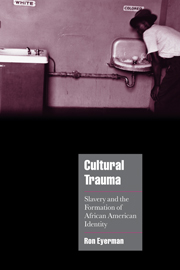Book contents
- Frontmatter
- Contents
- Acknowledgments
- 1 Cultural trauma and collective memory
- 2 Re-membering and forgetting
- 3 Out of Africa: the making of a collective identity
- 4 The Harlem Renaissance and the heritage of slavery
- 5 Memory and representation
- 6 Civil rights and black nationalism: the post-war generation
- Notes
- List of references
- Index
- Cambridge Cultural Social Studies
3 - Out of Africa: the making of a collective identity
Published online by Cambridge University Press: 22 September 2009
- Frontmatter
- Contents
- Acknowledgments
- 1 Cultural trauma and collective memory
- 2 Re-membering and forgetting
- 3 Out of Africa: the making of a collective identity
- 4 The Harlem Renaissance and the heritage of slavery
- 5 Memory and representation
- 6 Civil rights and black nationalism: the post-war generation
- Notes
- List of references
- Index
- Cambridge Cultural Social Studies
Summary
If we were a people much given to revealing secrets, we might raise monuments and sacrifice memories of our poets, but slavery cured us of that weakness. It may be enough, however, to have said that we survive in exact relationship to the dedication of our poets (including preachers, musicians and blues singers).
Maya AngelouA new African American Negro
In her discussion of the similarities between the Irish and the Harlem Renaissances, Tracy Mishkin (1998:69ff.) lists three ingredients that were central in the construction of an Irish identity. To counter the degrading racial and ethnic stereotyping perpetrated by the English, Irish intellectuals called upon the past, the peasants, and religion. A similar list could be made for those intellectuals and artists who composed the two interrelated currents of the New Negro movement that emerged out of the cultural trauma spurred by the end of Reconstruction and culminated in the urban Renaissance of the 1920s, on the energy provided by a new generation. Out of this movement emerged the idea of the African American, which reinterpreted the meaning of slavery as it renegotiated the borders of the collective and its memory. In the case of African Americans, the list would include much the same elements, the past, the peasants, and religion but with a slightly different spin.
- Type
- Chapter
- Information
- Cultural TraumaSlavery and the Formation of African American Identity, pp. 58 - 88Publisher: Cambridge University PressPrint publication year: 2001



